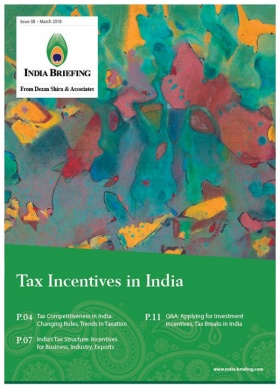GST Impact on Business in India: New Indirect Tax Administration, Benefit of Common Market
The new goods and services tax (GST) will replace all indirect taxes in India from July 1, 2017.
The federal and state government will concurrently impose the GST on almost all goods and services produced in India or imported into the country.
The GST will enhance India’s trade competitiveness by eliminating cascading taxes and transform India’s economy into a single ‘common market’. It will simplify the current tax structure and broaden the tax base, and could potentially boost India’s GDP by 0.9 to 1.7 percent.
Direct taxes such as the income tax, corporate tax, and capital gains tax will, however, not be affected under the new tax structure.
Apart from its macroeconomic implications, the GST will transform the way businesses are carried out in India.
In this article, we look at how the new indirect tax structure affects companies and the challenges they need to overcome to achieve successful compliance.
GST compliance for businesses
The new GST regime has implications for businesses across India as well as those planning to enter the Indian market. Entrenched ways of doing business will call for large-scale changes with respect to business planning, tax and accounting, budgeting, and investments.
The challenge at hand for the business community is to adapt to the transitional tax reforms by understanding the various nuances of the new GST regime.
Global experience shows that businesses that commenced their GST implementation projects sooner, achieved a much smoother transition and a better compliance track record.
A common market
Under the pre-GST tax system, multiple taxes and non-uniform tax laws across the country proved to be costly and burdensome for businesses operating and selling across multiple states.
The GST, which is a single comprehensive indirect tax levied on the supply of goods and services, will reduce the price difference between two states and make tax liabilities uniform.
A single tax will also ensure the free movement of goods and services across the states. It will make inter-state procurement of goods a viable option for businesses and open opportunities to consolidate suppliers and vendors.
Elimination of cascading taxes
Multiple taxes levied across the supply chain and on inter-state transfer of goods and services also cause cascading of taxes, that is, taxation on tax. These taxes act as hidden costs and increase the overall cost of production of goods and services.
The GST is based on input tax credit mechanism; it is a multi-stage consumption tax levied on each transaction of the supply chain, thus eliminating the process of double taxation.
Ease of doing business
The GST backed with a robust goods and services tax network (GSTN) system, will reduce the burden of procedural compliance, decrease paperwork, and remove tax barriers such as check posts on state borders and toll plazas.
Currently, truckers in India lose 60 percent of transit time at check posts, tolls, and other stoppages.
Once the GST e-way bill is implemented rightly, the benefits of simplified compliance, technological administration, and uniform process will contribute significantly to the ‘ease of doing business’ in India.
Supply chain efficiency
The GST calls for the redesigning of supply chain networks.
The new tax will decisively affect how companies operate their businesses, presenting significant opportunities for companies to secure a positive and lasting impact on their sales and profitability.
For instance, under the current system, supply chains are invariably designed to minimize the burden of inter-state taxes on the transfer of goods, with multiple warehouses located in different states.
The elimination of multiple indirect taxes will provide an opportunity to optimize supply chains, enabling companies to reevaluate existing procurement patterns, and distribution and warehousing arrangements.
GST: A major transition
According to industry observers, some sectors in the economy will gain more as their GST rate is expected to be lower than the current tax rates, while others sectors will lose as the rate will be higher than the present effective tax rate.
This may create additional challenges, necessitating changes in their business strategies.
- Transitional challenges
The GST is not merely a tax change but a business reform that will affect the entire spectrum of business activity, right from procurement, manufacturing, and distribution to the pricing of goods and the IT system. Therefore, companies will need to incur significant business process re-engineering (BPR).
This means they will have to reorganize their businesses in accordance with the new law, examine each business activity and conduct an impact analysis on their business, which might be a daunting task for small firms and involve high one-time administrative costs.
- Updating tax compliance systems
Once the GST is rolled out, a large amount of businesses’ tax compliance will go online. This necessitates firms to upgrade their online tax compliance systems as well as staff skills.
The government has launched the GST Portal – a dedicated portal for assistance with GST enrolment, GST registration, and the filing of returns.
However, given the short transition period for firms to be GST compliant, updating the whole system will be a challenging and expensive task for small businesses.
- Training staff
The GST is fundamentally different from the existing tax structure.
It will be essential for businesses to provide adequate training to their staff and clients on the new tax concept, legislation, and procedural aspects like enrolling and uploading returns online, so that they are well prepared for compliance deadlines.
- Pricing and profitability
The anti-profiteering mechanism under the GST requires businesses to quantify the benefit of the reduced tax rate and pass on the commensurate reduction in pricing to their customers.
The pricing of goods and profitability – compliant with this provision – cannot be done unless the rates are finalized by the government.
With only three months available to companies to be GST compliant, uncertainty regarding tax rates is a major concern for businesses.
Editor’s Note: For a glossary on the key concepts and terminologies used in the GST regime, see our article here.
About Us
India Briefing is published by Asia Briefing, a subsidiary of Dezan Shira & Associates. We produce material for foreign investors throughout Eurasia, including ASEAN, China, Indonesia, Russia, the Silk Road, & Vietnam. For editorial matters please contact us here and for a complimentary subscription to our products, please click here.
Dezan Shira & Associates provide business intelligence, due diligence, legal, tax and advisory services throughout India and the Asian region. We maintain offices in Delhi and Mumbai and throughout China, South-East Asia, India, and Russia. For assistance with India investment issues or into Asia overall, please contact us at india@dezshira.com or visit us at www.dezshira.com.
- Previous Article India-Bangladesh Economic Ties Boosted by Sheikh Hasina Visit
- Next Article The Waste Management Industry in India: Investment Opportunities













